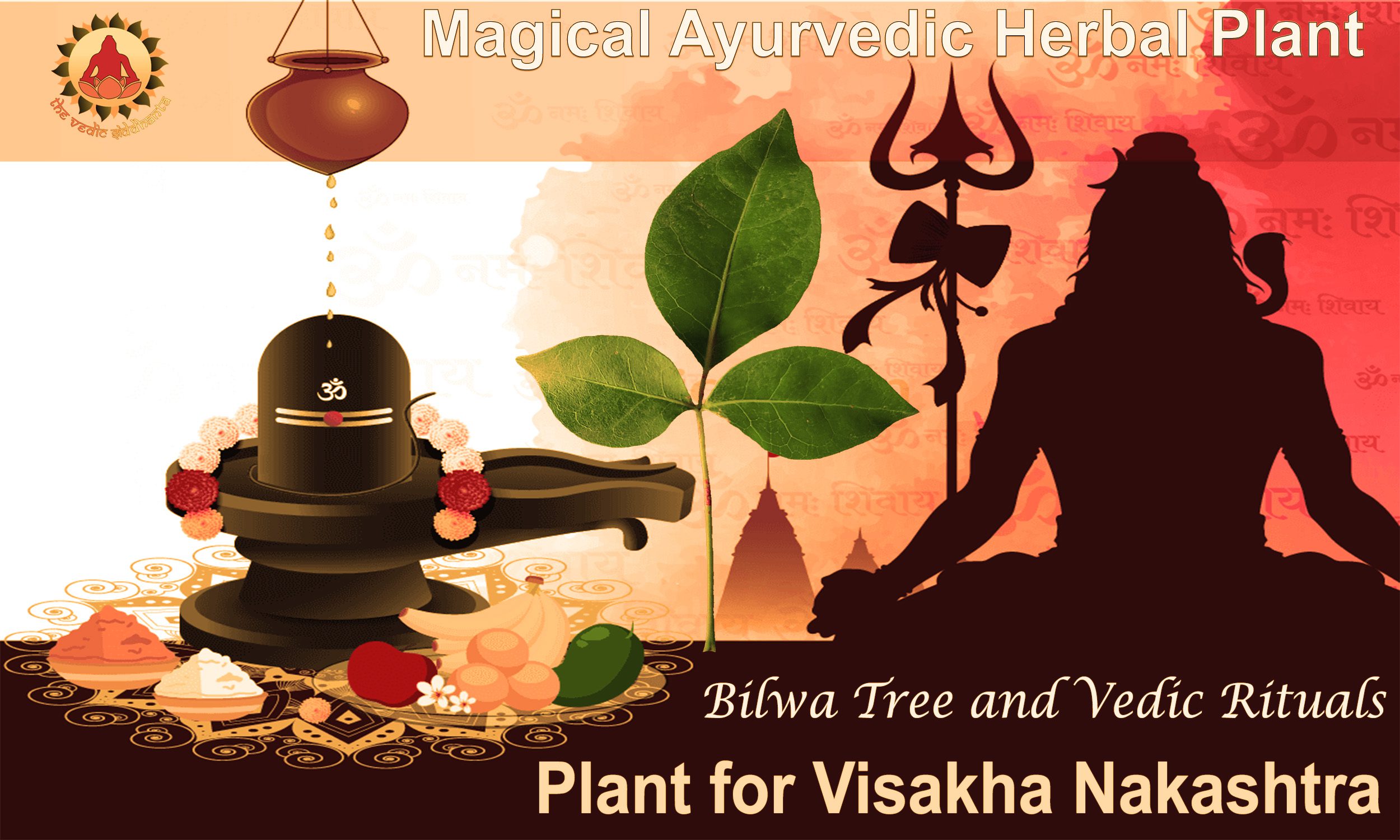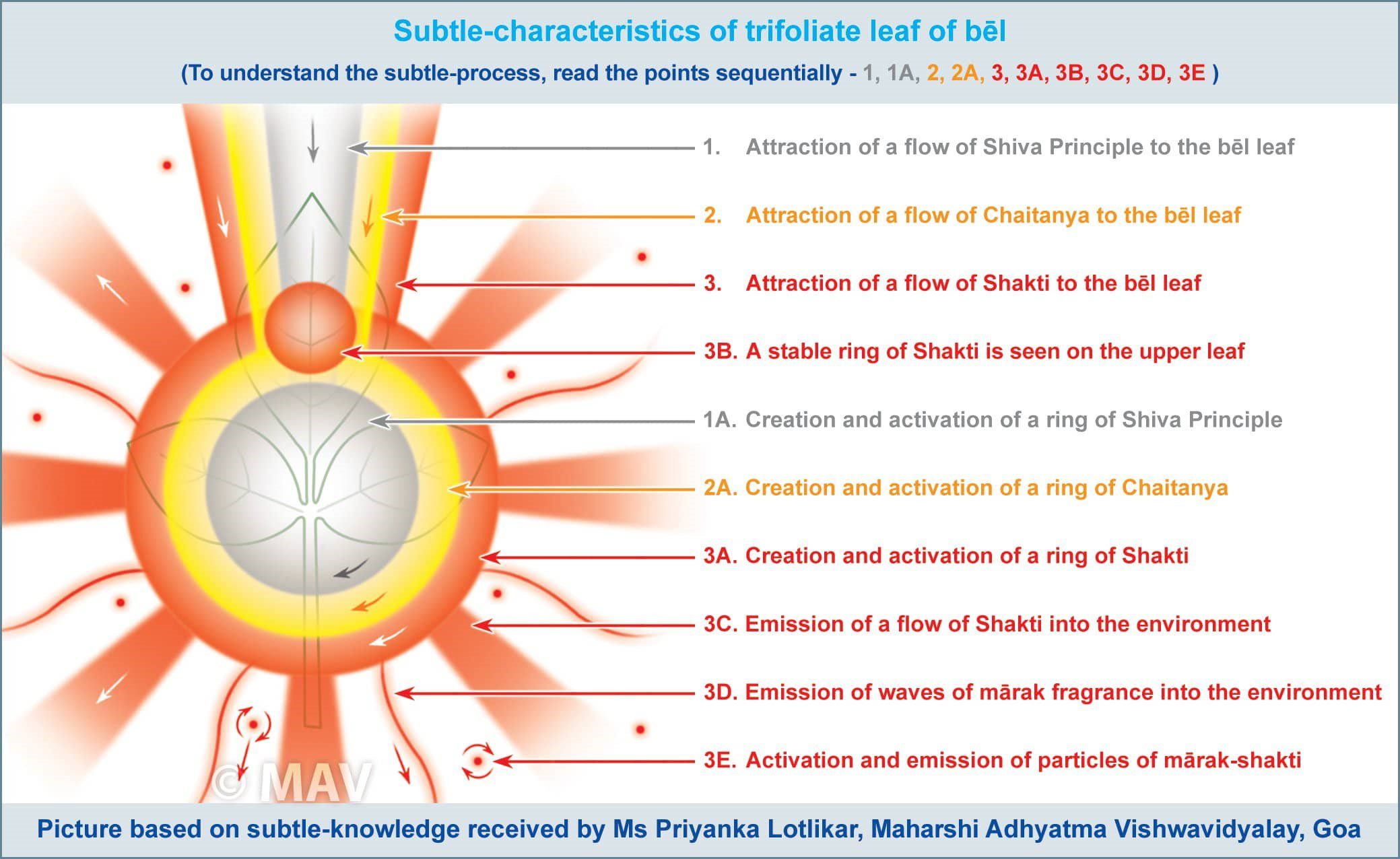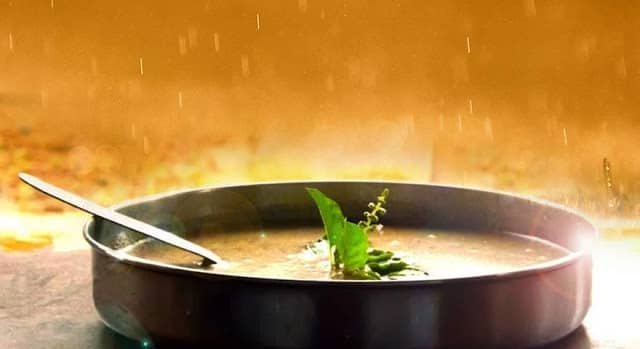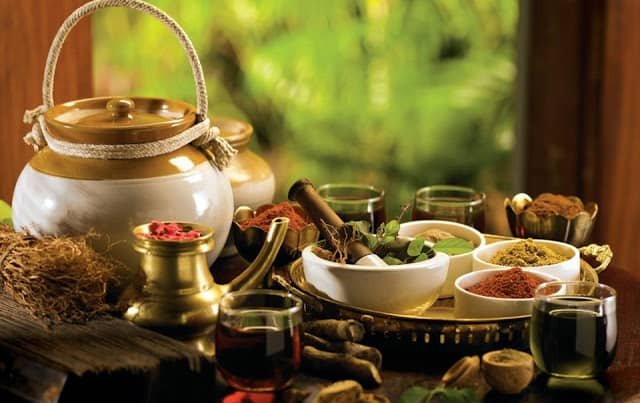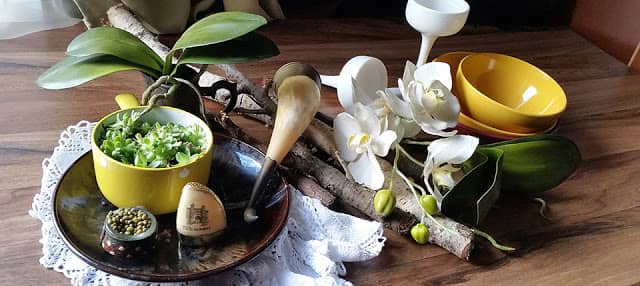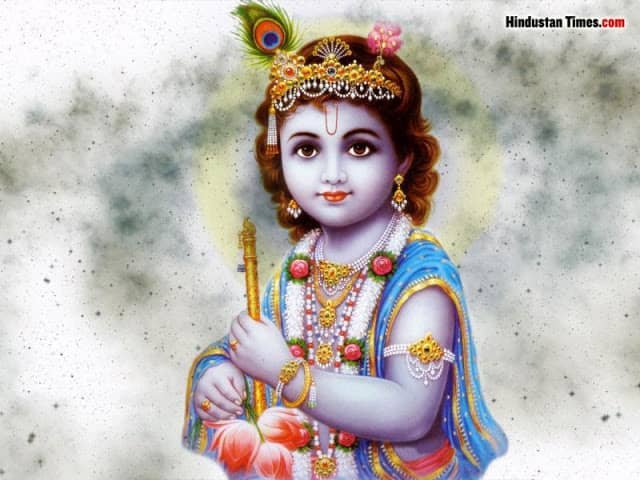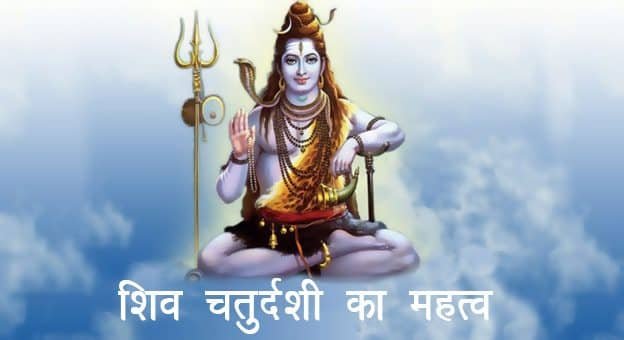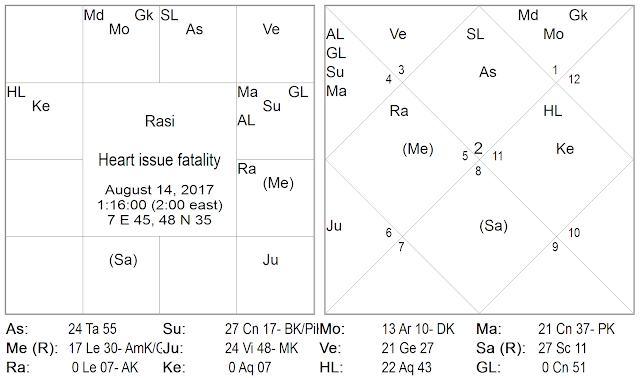Unveiling Ayurvedic & Astrological Wonders of Bel Patra/Bilwa Tree -Plant for Visakha Nakashtra
Written, Research and compiled | by Rocky Jamwal | August 2023
Unveiling Ayurvedic & Astrological Wonders of Bel Patra or Bilwa Tree – Healing Plant for Visakha Nakashtra
Indulge in our detailed exploration, examining the profound spiritual and curative privileges granted by the exceptional Bel Patra tree. Dive in, enrich your knowledge to explore ayurvedic and astrological miracles of bel patra or bilwa tree. Ayurveda is an old Indian medical science, while astrology is an ancient branch of the study of the heavens and their influence on human health. Together, these two fields shed light on the incredible relationship that exists between the natural world and the health of individuals. The astrological characteristics of Visakha Nakshatra are intertwined with the healing concepts of Ayurveda, and the constellation Bel Patra acts as a bridge between these two realms.
Introduction
According to an urban legend, the Bilwa Tree is said to have arisen from drops of perspiration that fell from Lord Shiva’s brow when he was participating in a celestial dance. This supernatural link with one of the Hindu trinities dramatically boosted the stature of Bel Patra, making it revered and cherished by devotees all over India.
In Vedic rites and astrology, the Bilwa tree, which is also known as Aegle marmelos, is considered to be of the utmost significance. Lord Shiva is one of the most adored gods in the religion of Hinduism, and this holy tree is seen as a representation of him. Because of their spiritual and therapeutic powers, the leaves, fruits, and roots of the tree are essential components in a variety of religious rites and practises.
It is said that Lord Shiva can be seen dwelling in the Bilwa tree, according to Hindu scriptures. It is stated that bestowing worship on this tree will result in an abundance of benefits and good fortune. The tree is revered during religious celebrations and other happy events because it is thought to bestow virtues such as cleanliness, fertile offspring, and financial success.
Astro-Ayurveda and Herbal Plants Research Series
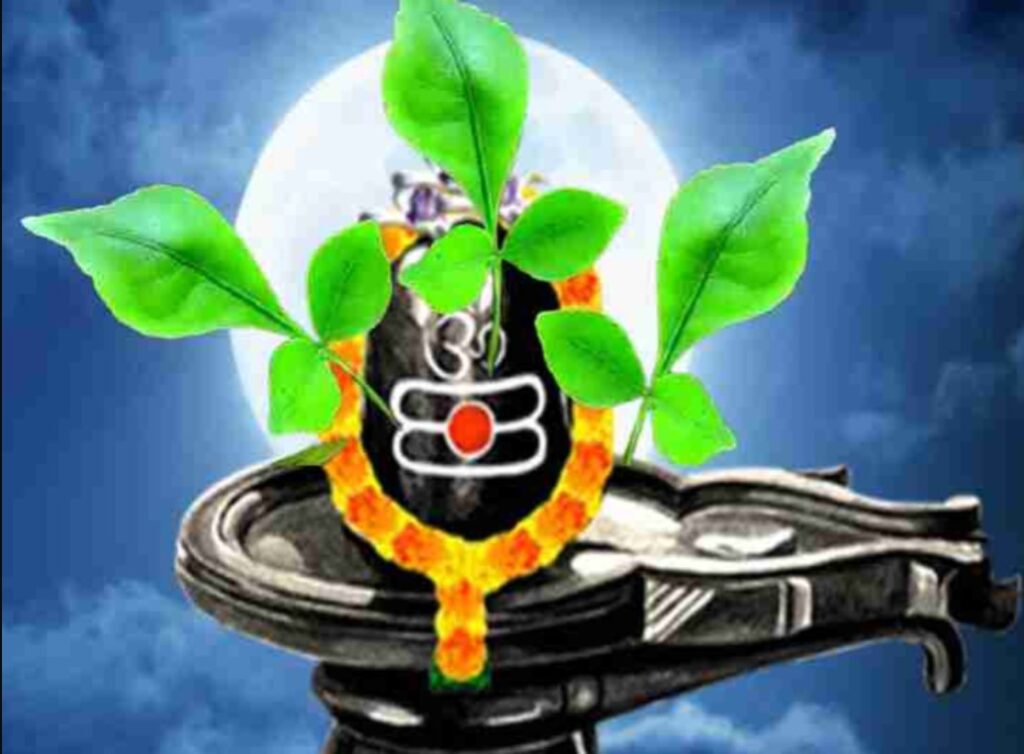
The Ayurvedic/Herbal Plant Bel Patra – Plant for Visakha Nakashtra
The Bilwa tree is utilised in a number of different ways throughout Vedic rites in order to call upon the divine for blessings. Garlands made out of the tree’s leaves are presented as an act of devotion to many deities. Garlands are made from the tree’s leaves. It is believed that making a gift of bilwa leaves to Lord Shiva will make him happy and will result in the requests being granted.
The holy Bilwa Patra Pooja is another ritual that makes significant use of the Bilwa tree in many ways. Prayers are said, mantras are chanted, and an offering ritual called aarti is performed using the Bilwa leaves. It is believed that by doing this action, one can cleanse negative energies from the surrounding area and so create an atmosphere that is spiritually chared.
The Importance of Astrological Factors of Bel Patra
According to astrological tradition, the Bilwa tree is connected to the planet Jupiter and Visakha Nakashtra, which is thought to bestow enlightenment, spiritual development, and prosperity upon its owners. It is believed that inviting good energies into a space and positively influencing one’s destiny can be accomplished by cultivating a Bilwa tree either indoors or outside.
In addition, according to Vedic astrology, worshipping the Bilwa tree can minimise the bad effects and result in positive improvements in a person’s life if they are going through a tough phase while being influenced by Jupiter’s malefic effects. This can be especially beneficial if the person is experiencing the difficult phase because of Jupiter’s malefic influences.
Biological and Medicinal classification of Bael
The scientific classification of bael is as below
- Kingdom: Plantae (Angiosperms)
- Order: Sapindales
- Family: Rutaceae
- Subfamily: Aurantioideae
- Tribe: Aurantieae
- Genus: Aegle
- Species: A. marmelos
- Binomial name: Aegle marmelos
Various names of Bael
- English name: Wood apple
- Arabic: Safarjale
- Bengali: Belpatthar ka paid
- Hindi: Bael
- Marathi: Belaache zaad
- Tamil: Vilvamaran
- Sinhala: Beli
- Gujarati: Billu
- Kannada: Belladi hannu
- Konkani: Gorakamili
- Malyalam: Koolam
- Marathi: Bel
- Odia: Baela
- Urdu: Bael
- Indonesia: Maja
- Thai: Matum
Ayurvedic Properties of Bael Tree

Bael, scientifically known as Aegle marmelos, is a plant of significant spiritual, religious, and medical importance, indigenous to India and Bangladesh, with subsequent distribution over Southeast Asia.
The maturation process of the fruit typically spans a duration of approximately 10 to 11 months. The wood apple possesses inherent qualities of sweetness, fragrance, and astringency. Bel, also known as Aegle marmelos, is a plant that possesses numerous advantageous properties and applications. It has been traditionally employed for the treatment of various ailments including tuberculosis, hepatitis, dysentery, constipation, peptic ulcers, piles, and a multitude of other conditions.
Furthermore, it has demonstrated utility in the treatment of worm infestations and gastrointestinal disorders. Bael or Aegle marmelos, commonly referred to as Bengal quince, golden apple, Japanese bitter orange, stone apple, among other names, is a plant species of interest. This fruit is recognised by multiple appellations, including Wood Apple, Kaitha, Maredu Pandu, Vilam Palam, Belada Hannu, Koovalam, Kothu, Koth Bel, and others. This particular plant is unique among Ayurvedic plants as all of its components, ranging from the root to the leaf, are utilised in the treatment of various ailments.
The consumption of this fruit is believed to have a harmonising effect on the Kaph and Vata doshas. Additionally, its roots have been traditionally associated with enhancing digestive processes, while its leaves are claimed to possess analgesic properties. Furthermore, the stem of this fruit is believed to have a positive impact on cardiovascular health, and the flowers of the bel plant have been traditionally used for the treatment of diarrhoea.
Read more on ayurveda ; Ritucharya: An Overview of Seasonal Regimen in Ayurveda by Dr Vikram
Ritucharya: An Overview of Seasonal Regimen in Ayurveda by Dr Vikram
The Sacred Bilwa Tree: A Connection to Vedic Rituals and Astrology

In the study conducted by V. NIGAM and V. S. NAMBIAR, it is stated that Aegle marmelos, also known as Bael, is a plant that is mentioned in the ancient Sanskrit medical text, Charak Samhita. The plant in question is widely recognised as a medicinal herb within the Ayurvedic and Siddha systems of medicine, as well as in several folk medicine traditions. It is commonly employed to address a diverse range of health conditions. Aegle Marmelos, also referred to as bael, is a member of the Rutaceae family.
According to Ayurvedic principles, bael is classified as a tridosh har, meaning it is believed to possess therapeutic properties that can alleviate imbalances associated with the three doshas: bile, wind, and phlegm. Aegle marmelos, often known as Bilva, holds significant religious and cultural importance in Hinduism since it is believed to symbolise the divine presence of Lord Shiva. This sacred tree is revered for its spiritual attributes and is said to possess mystical powers.
The Bilwa tree, also known as the Bael tree, possesses considerable religious and cultural importance in Hindu mythology, primarily due to its strong association with Lord Shiva. According to prevalent belief, Bilwa leaves hold significant importance in the ritualistic worship of Lord Shiva, since they are believed to serve as a dwelling place for the deity.
The leaves of the Bilwa tree have a trifoliate morphology, which symbolically represents the three primary qualities, known as gunas, namely sattva, rajas, and tamas. The term “sattva” is used to symbolise a state of purity, while “rajas” is associated with passion, and “tamas” is indicative of ignorance. Devotees participate in the ritualistic practise of presenting these leaves as an endeavour to cleanse and enhance their cognitive, corporeal, and metaphysical capacities, so cultivating a more profound communion with the transcendent being, Lord Shiva.
In the context of the veneration of Lord Shiva, adherents engage in the act of presenting a range of offerings, encompassing floral tributes, water, and fragrant substances such as incense. Nevertheless, the act of presenting Bilwa leaves carries a distinct importance. It is widely believed that the leaves possess the ability to appease Lord Shiva and bestow his divine gifts. As per the Shiva Purana, the act of presenting a trifoliate Bilwa leaf to Lord Shiva is considered equivalent to the offering of one thousand lotus blossoms. According to belief, the act of presenting this little tribute is said to be reciprocated by Lord Shiva, who bestows rewards as an expression of his devotion and affection.
The act of venerating Lord Shiva through the utilisation of Bilwa leaves is widely regarded to confer a multitude of advantages to adherents. Several examples of these include:
The act of offering Bilwa leaves with extreme dedication is believed to possess the ability to cleanse sins and negative karma, hence bestowing spiritual purity.
The acquisition of wisdom: It is believed that the Bilwa leaves create vibrations that might improve concentration, so facilitating the acquisition of knowledge and comprehension.
Physical and psychological healing: The therapeutic attributes of Bilwa leaves are recognised for their efficacy in alleviating many diseases and enhancing mental health.
The purported ability of Bilwa leaves to ward off malevolent forces and bad influences is attributed to the believed presence of Lord Shiva within them, which is said to establish a defensive barrier against such detrimental energies and maleficent entities.
Hence, the integration of the veneration of Lord Shiva alongside the use of Bilwa leaves within an individual’s spiritual regimen can yield profound and transformative outcomes in their existence.
The Bilwa tree is of great importance in the Shiva Purana, serving as a representation of profound devotion and spiritual advancement. Devotees engage in the act of presenting Bilwa leaves to Lord Shiva as a means of purifying themselves and beseeching his divine blessings. The advantages of this revered practise transcend the world of the physical, resulting in enhanced mental, emotional, and spiritual welfare. When encountering a Bilwa tree in the future, it is advisable to pause and acknowledge its inherent sanctity and the profound wisdom it embodies.
Embrace the ethos of unwavering commitment and observe its profound impact on the trajectory of your life.
What Scriptures says about Bilwa Tree:

Sri Sooktam Says ;
According to belief, the Bilva tree is said to have originated from the divine presence of Goddess Sri Maha Lakshmi. Additionally, the Sri Sooktham hymn serves as a form of praise and adoration for the revered Goddess Lakshmi.
“Aadithya varnae tapassodhi jaatho
Vanaspathi stava vrukshotha bilvaha
Tasya phalani tapasaanudantu
Mayaantha raayaashcha baahya alakshmeehi”
The translation of this stotra is given below.
“Oh Lakshmi, your complexion is like that of a morning sun; a vanaspathi (tree bearing fruits without flowering) called Bilva was brought forth as a result of your pious acts of austerity. My miseries and poverty, both internal (ignorance) and external, may be driven away by the fruits of the tree thanks to your favour. One who does austerities under a bilva tree and focuses their meditation on the deity Sri Maha Lakshmi is said to be blessed with the ability to have all of their wishes come true. This is a belief that has been passed down from generation to generation.
What Shiv Mahapurana Says;
The Bilva tree has been revered and regarded as a sacred and auspicious entity in Hindu writings and scriptures throughout history. Its profound sanctity is explicitly highlighted in the Mahapuranas, where its importance is elucidated through diverse manifestations of mantras. The Shiva Purana provides a specific account on the advantageous employment of bilva in human society, citing its scientific and therapeutic characteristics.
The 22nd chapter of the Maha Shiva Purana recounts the significance of the trifoliate Bilva Patra as a sacred symbol of Lord Shiva. Esteemed by all deities, the significance of this entity is challenging for individuals to fully grasp. The knowledge of the sacred tree is inherently limited in scope. The placement of sacred sites on Earth is exclusively situated at the foundation of this revered tree.
Individuals who engage in the practise of meditation upon Lord Mahadeva, namely in His linga form situated at the base of the Bilva tree, are able to achieve Moksha, the ultimate liberation, and experience spiritual purification through their connection with Shiva. The aforementioned wonders pertain to the revered Bilva.
The renowned Shri Bilvashtakam, namely in verses 6 and 7, makes reference to.
Lakshmyaascha stana utpannam Mahaadeva sadaa priyam, Bilva vriksham prayachchhaami eka bilvam Shivaarpanam. [Lakshmyaascha stana utpannam Mahaadeva sadaa priyam].
Darshanam bilva vrikshasya sparshanam paapanaashanam and Aghorapaapasamhaaram eka bilvam shivarpanam are both examples of bilvam shivarpanam.
Translation:
“I offer a single bilva leaf to Lord Shiva, who always holds great affection for the breasts that have emerged from the goddess Lakshmi. The act of beholding the bilva tree is believed to have the power to eliminate sins, while touching it is considered to be an act of purification. Offering a single bilva leaf to Lord Shiva is believed to be capable of absolving even the most heinous sins.”
The Bilva tree holds a special significance for Mahadeva since it is said to have originated from the divine essence of Goddess Lakshmi. I request the tree to present a bilva leaf as an offering to Lord Shiva. The act of observing the Bilva tree and making physical contact with it is believed to possess the ability to absolve individuals of their transgressions. The most severe karmic consequences can be mitigated through the act of presenting a Bilva leaf as an offering to the deity Lord Shiva.
According to popular belief, the bel tree is also considered to be the abode of Lakshmi, the deity associated with wealth. Individuals who engage in the ritualistic practise of puja, specifically directed towards the deities Shiva and Parvati, with unwavering devotion and employing the utilisation of leaves, shall be bestowed with profound spiritual abilities.
Spiritual Essence of Bilwa Tree
Offerings of leaves have been made to gods and goddesses like Shiva and Parvathi in religious ceremonies going all the way back to ancient times. The Bael tree is a sacred deciduous tree that is closely associated with a number of gods and goddesses due to its significant medicinal properties, in particular its calming effects. The aforementioned tree is extremely well-liked in Shiva and Vishnu temples, and it is frequently referred to as the temple garden plant because of its prevalence in these religious spaces.
It is possible to cultivate it in any dwelling that is used for domestic purposes. This particular plant has trifoliate leaves, which are arranged in a manner that is symbolic of the three main deities of Hinduism: Brahma, Vishnu, and Shiva. There is a striking resemblance between the individual leaflets of the trifoliate leaves and the trisoolam, which is the legendary weapon linked with Lord Shiva. The sacred importance of the tree extends to the Jain religion as well.
Under a bael tree, Bhagwan Parasnathji, the 23rd Tirthankara, attained knowledge and became the Tirthankara. In temples dedicated to Shiva, worshippers receive leaflets as prasadam, and in temples dedicated to Vishnu, they receive tulsi. The religious significance of Bael cannot be overstated. In the context of the Hindu religion, it is common practise to make offerings to various deities during prayer rituals by presenting the leaves and fruit of a specific plant. The worship of Shiva is given a particular focus within this setting.
In addition, the leaves of this plant are utilised in the religious ceremonies of the Viva Rupra and the Parvati. There is ample evidence that the fruit is utilised in religious rites and ceremonies, as well as that it is mentioned in both the Vedas and the Mahabharata.
In the research paper that Neha Parmar, Suman Singh, and Bhupesh Patel produced, a detailed historical and ethno-medical analysis of Bilva Patra is provided. An extensive number of references from ancient writings such as the Yajurveda, Atharvaveda, Brahmanas, Kalpasutras, and Puranas are cited in the work, which is an indication of the broad acceptance and use of bilva in traditional medicinal practises.
This topic is also discussed in the Mahabharata and the Ramayana, both of which were written by Valmiki. The Taitiriya Brahamana mentions the Bilva tree as a tree linked with auspiciousness, while the Baudhayana Dhamasutra acknowledges the Bilva tree as one of the venerated trees in its historical setting. It was believed that the fruit known as bilva, which was considered to be the most sacred of all fruits at the time, held enormous religious and cultural significance in the historical context of ancient India.
It was most frequently utilised in temple settings as the major food offering that was delivered to the gods and goddesses there. The coconut has surpassed the bilva fruit as the fruit of choice for religious offerings in modern times. It is also commonly regarded as a symbol of total submission to a superior authority at this time. The symbolism of the Bilva plant is prominently featured throughout the Hindu faith.
On the crown and the trident of Shiva, the trifoliate leaves of the Bilva plant are depicted extensively in prominent positions. In addition, the three points at the end of each leaf represent the holy trinity that is comprised of Brahma, Vishnu, and Shiva. In order to lessen the impact of the unfavourable effects, the amulets were fashioned and worn with the intention of doing so. The plant in question has been extensively acknowledged as a symbol of corpulence and fecundity due to its progressive development from the base to the uppermost branches, which is accompanied by an annual production of fruits. This has led to the plant being widely identified as a representation of corpulence and fecundity.
One of the eight leaves of bilva that are presented to Lord Shiva as an offering is believed to be the Mokshasadhanam, or the means by which one can achieve liberation, in accordance with the Lingarchanchandrika, which is a sacred text. This belief is based on the belief that one of these leaves is the Mokshasadhanam. According to Maitra, the bilva tree has a reputation for being able to encapsulate the spirit of heavenly illumination. The Shankhyana Aranyaka suggests that in order to accomplish a number of goals, one should adorn themselves with the ‘Bilva Mani’ as a type of decoration. This is done in the hopes of achieving the results they seek.
The elimination of unpleasant dreams (Dusvapnanashana), the destruction of malicious energies (Rakshoghna), the accomplishment of rejuvenation and longevity (Rasayana), the maintenance of progeny (Prajasthapana), and the protection against venomous substances (Vishaghna) are some of these benefits.
Bathing with water that has been flavoured with Bilva Patra is considered to be a traditional part of the wedding ceremony. In addition, the Upanayana Samskara recommends that its practitioners dress in bilva-danda. Bilva was used as a tool or implement by the Babylonians circa 7000 years ago. According to the findings of a study that was carried out in 1996 by Alimas and colleagues, the significance of trees extends to the Jain religion. The Jain people regard trees as sacred because of their connection to Bhagwan Parasnathji, the 23rd Tirthankara, who is believed to have attained enlightenment while sitting beneath a Bilva tree.
It is stated in the Agnipurana that the act of inhaling the oil that is extracted from this particular plant is thought to enhance the individual’s poetic powers as well as promote lifespan.
In addition, gastroenteritis can be treated by administering a decoction that is made of Bilva fruits, Mangifera indica, Dolicos lablab, Woodfordia fruiticosa, and Zingiber ofcinale, together with molasses and buttermilk. Another treatment option that is indicated is the consumption of a decoction that is comprised of bilva, aconitum heterophyllum, and holerrhena antidysenterica. This is an alternative treatment. Traditional beliefs ascribe curative qualities to bilva, specifically those that enable it to alleviate fevers, as well as the discomfort and coughing that accompany fevers.
The Shiva Mahapurana & the Story of hunter

In the Shiva Purana, the story of the repercussions of venerating Lord Shiva with the bel leaf is recounted in narrative form.
On the night of Maha Shivaratri, a hunter was driven to go out and engage in hunting activities because of the urgent need to satisfy the hunger of his family. Due to the fact that this day is devoted to the worship of Lord Shiva, it carries with it a tremendous religious significance.
In the end, the hunter was unsuccessful in his attempts to find any game. The individual climbed up a tree that was located close to a body of water and assumed a stance of expectancy, with the hopes of witnessing a creature that was unaware of its surroundings that was seeking hydration. This person had no idea that the tree they had climbed was actually a bilva tree until after they had reached the top. A Shivling, an artefact that represents the god Shiva and is venerated for its role in religious worship, was found near the bottom of the tree where it had been planted.
The person consistently scattered bilva leaves into the ground over the night, and these leaves eventually settled on the Shivling. This behaviour continued until the morning. Because of the hunter’s unintentional worship of Lord Shiva, he was able to undergo a profound transformation that endowed him with the attributes of empathy and comprehension. As a result, he was released from the burden of the negative actions he had committed in the past.
The advent of the bilva tree is said to have been caused by the perspiration of Parvati, who is the consort of Shiva, according to the Nagara Khanda of the Skanda Purana.
As a result of all of the strenuous tasks that she engaged in, the goddess Parvati, who is also known as the renowned Daughter of the Mountain, became exhausted. Her forehead began to sweat, and a bead of moisture eventually fell to the ground below. The Mandara mountain, which is rather visible, is home to a tree that has achieved great growth.
Parvati suggested that the tree, which had emerged from the earth near to her, be given the name Bilva. Bilva was the name of one of the gods.
If a person approaches this tree with the utmost reverence and collects its leaves, they will surely elevate themselves to the position of supreme ruler over the surrounding territory. If a person with steadfast faith were to engage in the act of worship towards me, using the leaves as a conduit, they would be able to have any wish they had come true that they may have. If a person is able to maintain even a rudimentary level of belief in the ritual of worship while looking at the leaves of the bilva plant, then I will definitely bestow abundant blessings upon that person.
If a person makes the decision to consume the very tip of the foliage, then a great number of their indiscretions are automatically removed from their record. In the event that an individual places the tip of a leaf upon their cranium, it is believed that no type of pain delivered by Yama, the Hindu deity of death, shall cause that individual to experience misery. This is because the apex of the leaf is placed upon the individual’s head.
The leaf known as Bilva-Patrais comes from a tree in the Hindu religion that is considered to be sacred. This tree is named Bael (). Its sanctity is analogous to that of the leaves of the Tulsi plant. In point of fact, the use of Bilva-Patra by Shiva is analogous to the use of Tulsi leaves by Vishnu. In English, the word “Bael” can also be translated as “Stone Apple,” “Wood Apple,” “Golden Apple,” or “Bengal Quince.” It is most generally referred to as Bael or Bel in Hindi, and a leaf of Bael is referred to as Bel-Patta. The bird is called “Aegle Marmelos” in the scientific community.The word for this in Sanskrit is Bilva-Patra.
In Hindu Scriptures, it is said to have originated within the chest of the goddess Lakshmi. The following is made abundantly obvious by the sixth “Shloka” of the “Bilvashtakam”:
लक्ष्म्याः स्तनत उत्पन्नं महादेवस्य च प्रियम्
बिल्ववृक्षं प्रयच्छामिबिल्वपत्रं शिवार्पणं ।6।
Lakshmya stanat utpannam mahadevasya ch priyam
bilvavriksham prayachchhami bilvapatram shivarpanam.
Meaning:
I make this offering of the bael tree, which is said to have grown from the centre of Goddess Lakshmi and is favoured by Mahadev. As a result, I make an offering of Bilva-Patra to the god Shiva.
A Bilva-Patra leaf is a compound leaf, which means it is composed of three individual leaflets. Shiva is quite fond of the Bilva-Patra, which has three leaves, and it is given to him as an offering. It is quite uncommon for a single leaf to produce more than three leaflets, which is one of the things that attracts the attention and interest of devotees. On the premises of the Baba Baidyanathdham Temple, where the complex is located, I have witnessed such leaves being offered for sale at a higher price. However, it is not appropriate to present Shiva with these leaves, as it is made abundantly plain in the first “Shloka” of the “Bilvashtakam” as follows:
त्रिदलं त्रिगुणाकारं त्रिनेत्रं च त्रयायुधम्
त्रिजन्म पापसंहारम् बिल्वपत्रं शिवार्पणं ।1।
Tridalam trigunakaram trinetram ch tryaudham
trijanma pap-sanharam bilvapatra Shivarpanam.
Meaning:
(As an offering, I present the three-leafed Bilva-patra, which possesses the attributes of Sat, Raj, and Tam, which symbolises the three eyes of Shiva as well as the three weapons, and which purges the sins of three previous incarnations.)
Explanation :
This “Shloka” is also spoken when presenting Shiva with the bilva-patra sacrifice. In addition to having three leaflets, it should have the following characteristics: it should be soft, without holes, without spots (), and unbroken. It is necessary to cut away the more substantial portion of the ‘Belpatta’ twig () that is linked to the tree (called a vajra). When making an offering to Shiva or any of the other gods, the “Belpatra” should be turned over so that the smooth side is towards the “Linga” and the pointy end should be facing away from the devotee. There is a text called the “Bilvashtakam” that is eight verses long and discusses the significance of Bilva-Patra.
In order to prepare the leaves for the offering, a white sandalwood paste () is either rubbed into them or sprinkled over them. The beverage known as Bilva-Patra is presented to not only Shiva but also each and every member of the Shiva family ( ), including Nandi the Guard. Ganesh, Gouri (Shakti), and her incarnations like as Durga, Kaali, and Kartikeya are all given Bilva-Patra as an offering.
People sometimes write “” with sandalwood paste () or kunkum () on leaflets and then gift them to Shiva since Shiva is similar to a follower of Rama. Since Hanuman is an avatar of Shiva and is also known as the Rudra avatar, the ‘Bilva-Patra’ is also presented to Hanuman during his worship.
Some devotees are of the opinion that the three leaflets of the Bilva-Patra are symbolic representations of Shiva’s three eyes: the two lower leaflets are thought to stand for Shiva’s two normal eyes, while the one upper leaflet is thought to represent Shiva’s third eye, which is located on his forehead.
In Bhubaneswar, a Pundit at the Shiva temple provides holy water along with a piece of Bilva-Patra to worshippers, just as he does in every other temple in North India. This holy water is called “Charanamrit” and it contains Tulsi leaves.
The amount of bilva-patras that are presented to Shiva can range anywhere from one to more than lakhs, depending on the individual’s ability to procure them and their financial situation. During the months of “Saavan” and “Aashaadh,” I was present when some devotees presented Baba Basukinath with an offering of one lakh and twenty-five thousand ( ) Bilva-Patras.
Even though it is common practise to refrain from offering the same thing to a deity more than once, in the case of the Bilva-Patra, if someone does not have access to it and they observe some Bilva-Patras being placed over the Shiva-lingam, they are allowed to grab one, wash it and then re-offer it to Shiva. Because Shiva is so merciful to his devotees, he even acknowledges and appreciates the intangible gifts they give him. As is the case in the opening verse of “Shiva Manas Pujan Stotram,” numerous items, including Bilva-Patra, are offered in the imagination:
Ratnaih kalpitam aasanam himjalaih snanam ch divyambaram
Nana ratna vibhooshitam mrigmadamodankitam chandanam
jatichampakvilvapatra rachitam pushpam ch dhoopam tatha
Deepam dev dayanidhe pashupate hritkalpitam grihyataam.
Meaning : The Bilva-Patra and the fruits inspire devotees to bring this tree into their homes on the university campus. The presence of a bilva-tree on the campus contributes to the expansion of one’s money, name, and popularity. Not only this, but because the tree of Bael is a representation of Shiva himself, after people get out of bed in the morning, they look at the tree and say “namaskar” to it, as well as pronounce this “Shloka,” which is a verse from the Shiva Purana.
Darshanam Bilva Vrikshasya Sparshnam Papnashnam
Aghor Papsanharam Bilvapatram Shivarpanam.
Meaning : The act of worshipping the Shiva-linga beneath a ‘Bilva Tree’ yields significant benefits. The act of irrigating a ‘Bilva-Tree’ with ordinary water or water from the Ganges river, often known as ‘Jalam’ or ‘Gangajalam’, respectively, is believed to bestow the spiritual merit equivalent to visiting all sacred pilgrimage sites, known as ‘Tirthas’. The act of applying water sourced from the vicinity of the tree’s root to the forehead results in the eradication of all “Papam”.
Astrological Importance of Bilwa Patra

Individuals who are born under the influence of the Visakha Nakashtra and Scorpio moon sign, or those who have a birth in the Visakha Lagana nakshatras, are advised to engage in the practise of planting a Bilwa Patra tree in their personal garden and providing it with regular watering. Alternatively, individuals experiencing health concerns associated with the liver or stomach are recommended to consume Bilva juice on a daily basis. This practise is believed to counteract any adverse effects cau
The experience of meditation beneath this particular tree has the potential to evoke a profound sense of bliss among individuals born under the Visakha Nakashtra. In addition to the act of planting, it is recommended to perform Rudra abhishek, a ritualistic offering, using Bilwa Patra, fruits, milk, and the remaining Panch Amrits. The malefic effect of Jupiter can be remedied at an accelerated rate via meticulous attention and unwavering dedication.
Anyone whose Bhadhaka planet is Jupiter are advised to engage in the practise of planting or donating a Bilwa plant to anyone in need or near the Shiva Linga within a temple dedicated to Lord Shiva. This ritual is believed to effectively mitigate the adverse effects associated with the Bhadhaka planet.
In the event that Jupiter exhibits malefic influences, it may potentially manifest adverse effects on liver functionality, resulting in elevated enzyme levels, unregulated sexual appetite, complications with the gall bladder, disturbances in kidney enzyme activity, and occasionally an escalation in the incidence of infections or diabetes. Excessive heat in the stomach and liver can result in elevated levels of bilirubin, leading to the manifestation of jaundice. Additionally, this condition may contribute to bodily weakness, gastric disturbances, and the development of constipation, among other potential consequences.
The reason for this is in accordance with the framework of the five limbs. Nakshatras are recognised and observed for their influence on mental and physical well-being. Any disruption to the native’s birth nakshatras has the potential to adversely affect their mental and physical well-being. One predominant factor contributing to the susceptibility of those with illnesses in the Scorpion moon and Visakha Nakashtra’s lord via nodes to liver and reproductive organ issues is their Dasha padas.
The potential association between the Visakha Nakashtra deity and deities such as Indra, who embodies transformation and strength, and Agni, the god of fire, may contribute to the inclination of Visakha individuals towards extremity in several aspects of life, including their sexual desires, pursuit of power, and appetite for success.
An elevation in the levels of Tamsik and Rakashas Gana within this nakshatra has the potential to result in health complications stemming from excessive engagement in sexual activities, heightened hunger, increased appetite, impaired digestion, gastrointestinal problems, flatulence, and predominantly liver-related ailments.
The most effective solution for alleviating the negative effects associated with the Viskhna Nakashtra (Scorpion) moon sign entails the cultivation of a bilwa tree and the regular consumption of bilwa fruit, as well as the practise of worshipping Lord Shiva using Bilwa Patra and fruit.
Medically speaking, bilwa has a wide range of applications, including the following:
1) It has the ability to treat conditions such as diarrhoea, cholera, haemorrhoids, and vitiligo.
2) It can lessen the severity of ulcers in the stomach.
3) Capacity to fight microorganisms
4) It is effective in treating scurvy.
5) is capable of regulating cholesterol levels.
6) has the ability to remedy breathing issues.
7) Used to reduce inflammation.
8) It can be used as a treatment for conditions related to the heart.
9) has the ability to relieve constipation.
10) has the ability to manage diabetes.
Nutritional Value of Bael Fruit
The various nutrients in a bael fruit per 100gm.
Nutrients Amount
Carbohydrate 31.8 gm
Fat 0.3 g
Proteins 1.8 gm.
Vitamins
Vitamin A 55 mg.
Vitamin B Rich in Vitamin B1 and B2
Vitamin C 60 mg.
Thiamine 0.13 mg.
Riboflavin 1.19 mg.
Niacin 1.1 mg.
Carotene 55 mg.
Minerals
Calcium 85 mg.
Potassium 600 mg.
Fiber 2.9 gm.
Water 61.5 g.
Energy 137 k.cal
Energy 137 k.cal
There are ten advantages to eating bael.

- Treatment of TB with Bael According to Ayurveda, this herb can be used as a treatment for TB.
- The use of bael for the treatment of gynaecological conditions The use of bael on a regular basis can help avoid gynaecological conditions.
- Urinary disorders and Bael: The consumption of bel can assist in the resolution of issues associated with urinary disorders.
- A Bael for the Prevention of Diabetes: Bitter and pungent, it is loaded with antioxidants and helps stimulate the pancreas to generate insulin, which in turn results in a reduction in blood sugar levels. Diabetes can be treated with the leaves of the plant.
- Bael for Digestive Disorders: It protects the digestive system from ulceration, lowers the frequency of Irritable Bowel Syndrome (IBS), and lessens intestinal spasm, making it useful for the treatment of diarrhoea, dysentery, and other infections of the elementary canal.
- Bael has been shown to be effective in the treatment and prevention of fever when the leaf juice is combined with honey.
- Tonics made from flowers are often recommended for people who suffer from epilepsy.
- Nutritional Information Regarding Bael It has a high concentration of alkaloids, polysaccharides, antioxidants, beta-carotene, vitamin C, vitamin B, and a wide variety of other biochemical compounds. Tannins, calcium, phosphorus, iron, protein, and fibre are some of the other components that can be found in it. The following nutrients can be found in one hundred grammes of bael: Value in terms of calories (137), moisture content (61.5g), protein (1.8g), fat (.3g), minerals (1.7g), fibre (2.9g), carbohydrates (31.8mg), calcium (85mg), phosphorus (50mg), iron (.7mg), beta-carotene (55 UG), thiamine (.13mg), niacin (1.1mg), vitamin C (8 mg), and copper (.21 mg).
- The Use of Bael for the Treatment of Pile: It is beneficial to use the extract of unripe bel fruit in the treatment of piles and haemorrhoids.
- As a result of the calming effects that it has on the digestive system, bael lowers the amount of acidity that is produced in the stomach. This property makes bael effective for the treatment of ulcers of many types, including gastric ulcers, gastroduodenal ulcers, and others.
The applications of Bael
- The juice derived from this particular fruit is commonly utilised in the creation of beverages and fruit concentrates, particularly during the summer season, owing to its inherently saccharine and agreeable qualities.
- The fragile leaves of the Bael tree are commonly utilised in culinary applications, particularly as ingredients in salads.
- The process of absorption carried out by this substance contributes to the purification of the atmosphere by effectively removing hazardous gases.
- This substance is employed to enhance one’s appetite.
- The oil derived from it is utilised for the treatment of respiratory ailments.
- It finds application in the production of confectionery, beverages, caramel, powdered extracts, and several edible commodities.
The medicinal properties of the bael fruit
- The therapeutic properties of Bel are attributed to its rich composition of many biochemical compounds, including alkaloids, antioxidants, polysaccharides, and essential oils.
- The interior flesh of the bael fruit possesses various beneficial properties, including curative, pesticidal, nutritional, and therapeutic attributes. Consequently, it is utilised for the management and alleviation of numerous ailments and disorders.
- The leaves of the wood apple tree has therapeutic properties and are employed for the purpose of reducing blood cholesterol levels.
- The substance possesses anti-inflammatory properties. The application of its extracts to the affected area has been found to be effective in the treatment of inflammation.
- The roots of Bael possess antidiarrheal properties, serve as an antidote for snake venom, and have anti-inflammatory effects that aid in the process of healing.
The potential benefits of consuming Bel juice.
- Bel juice possesses beneficial characteristics that make it effective in alleviating constipation due to its laxative effects.
- Bel juice provides effective relief for conditions such as heartburn, acidity, hyperacidity, and indigestion.
- In the case of individuals experiencing intestinal parasites, it is recommended to consume bael juice because to its potential antidotal properties.
- The consumption of Aegle marmelos juice has been found to have potential benefits for cardiovascular health and cognitive function. The combination of Bel juice and ghee has been found to have potential benefits in the prevention of heart disease. Additionally, it is employed as a cardiac tonic.
- The consumption of raw Bel leaves has been found to be effective in addressing several gastrointestinal issues.
- Bael juice is a beverage that is known for its high vitamin C content and its potential efficacy in the treatment of scurvy.
It is important to use caution
Bael, a plant of Ayurvedic significance, possesses advantageous properties; nonetheless, it is not without its associated adverse consequences. Prior to consuming the fruit, it is advisable to practise prudence under the following circumstances.
- Abdominal issues might arise as a result of excessive ingestion of bael.
- Constipation may occur as a result of consuming a higher quantity of the fruit.
- During pregnancy, it is not recommended to consume Bel.
- nursing: It is advisable to refrain from engaging in nursing.
- Surgery: Its utilisation should be avoided in surgical procedures.
- Diabetes: It is important to use caution while administering medication aimed at reducing blood sugar levels, as there is a possibility of inducing hypoglycemia. Consequently, diligent monitoring of blood sugar levels is advised.
- Hypertension: Individuals with elevated blood pressure should refrain from consuming this particular fruit.
Conclusion :
Overall we can say that bilwa leaves are revered for their ability to pacify deities and grant celestial gifts. It is believed that Shiva, who bestows prizes as an expression of devotion and respect, will acknowledge and appreciate this modest tribute by giving gifts.
I hope you will like this article and follow these rituals and benefits of Bael in your day-to-day life to have better spiritual and physical health. Keep reading and keep sharing.
With thanks and Regards,
Rocky Jamwal
Source and Reference:
Ayurveda Medical Dictionary by Ranganayakulu Potturu
https://bsienvis.nic.in/Database/MedicinalPlants_3939.aspx
https://archive.org/stream/AstangaHrdayam.Eng/Astanga-hrdayam.%20Eng_djvu.txt
Skanda Puran, Chapter 250, Creation of bilwa Tree
Sacred Plants of India by By Nanditha Krishna
https://www.biodiversityofindia.org
Historical and Ethno-Medical Review on Bilva by Neha Parmar, Suman Singh, & Bhupesh Patel
Therapeutic potential of Aegle marimelos leaves as an Antioxidant and anti-diabetic agent : A review by
V. NIGAM AND V. S. NAMBIAR
Wikipedia
Views: 372


